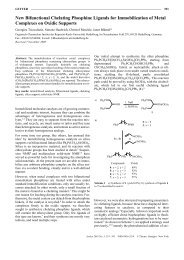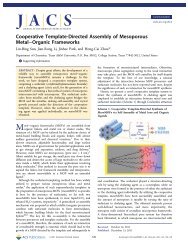Singlet Fission - Department of Chemistry
Singlet Fission - Department of Chemistry
Singlet Fission - Department of Chemistry
You also want an ePaper? Increase the reach of your titles
YUMPU automatically turns print PDFs into web optimized ePapers that Google loves.
D Chemical Reviews, XXXX, Vol. xxx, No. xx Smith and Michl<br />
Figure 3. Dye-sensitized solar cell that uses a singlet fission<br />
sensitizer (C1) in conjunction with a conventional sensitizer (C2).<br />
The C1 sensitizer comprises the top layer <strong>of</strong> the cell and absorbs<br />
light above 2 eV. The C2 sensitizer absorbs the remaining light<br />
between 1 and 2 eV. CB, conduction band; VB, valence band; CE,<br />
counterelectrode; NHE, normal hydrogen electrode.<br />
Figure 4. Schematic sketch <strong>of</strong> theoretical efficiency as a function<br />
<strong>of</strong> the S0-T1 band gap for a singlet fission solar cell defined<br />
in Figure 3 (red) and a conventional dye-sensitized solar cell<br />
(blue).<br />
carriers separately and quantitatively (Figure 3). The ideal<br />
efficiency <strong>of</strong> such a singlet fission cell is shown schematically<br />
as a function <strong>of</strong> the S0-T1 band gap in Figure 4, assuming<br />
a 200% yield <strong>of</strong> charge carrier pairs per photon. The optimal<br />
location <strong>of</strong> the S0-S1 absorption edge is ∼2 eV, with the<br />
triplet energy at ∼1 eV, but minor deviations from these<br />
values would have little effect. In the derivation <strong>of</strong> the<br />
optimum efficiency value close to 1/2, it was assumed that<br />
the layer doped with singlet-fission capable sensitizer absorbing<br />
at 2 eV and above would be immediately followed by a<br />
layer <strong>of</strong> an ordinary sensitizer capable <strong>of</strong> absorbing photons<br />
<strong>of</strong> energies between 1 and 2 eV and generating a single<br />
electron and hole per photon. It is then arguable whether<br />
the assembly can still be called a single junction cell, but<br />
because no current matching is necessary, even if it is viewed<br />
as a double junction cell, it would be one <strong>of</strong> a particularly<br />
simple kind.<br />
There would be an intrinsic advantage to the use <strong>of</strong> triplets<br />
for electron or hole injection, since back electron transfer to<br />
yield the ground state would be spin-forbidden. The longer<br />
lifetime <strong>of</strong> the triplet would provide more opportunity for<br />
charge separation but also more opportunity for quenching,<br />
for example, by charge carriers.<br />
A sensitizer capable <strong>of</strong> singlet fission needs to contain<br />
more than one excitation site. While the use <strong>of</strong> covalent<br />
dimers or oligomers in dye sensitized solar cells is similar<br />
to the already well established use <strong>of</strong> individual molecular<br />
dyes, 27-29 the injection <strong>of</strong> charges from molecular crystals,<br />
aggregates, or polymers is likely to present challenges. This<br />
is at least partially due to the fact that single molecules can<br />
be more easily specifically and covalently bound to oxide<br />
surfaces, securing efficient electron transfer and charge<br />
collection. The difficulty with crystals is that they would need<br />
to be extremely small in order to be useful as semiconductor<br />
sensitizers. Nanocrystalline semiconductor films used in<br />
photovoltaic cells, such as TiO2, typically have a porosity<br />
<strong>of</strong> ∼50% and a grain size in the range <strong>of</strong> 10-80 nm, 29 and<br />
charge transfer to the macroscopic electrode occurs by grainto-grain<br />
hopping. For efficient charge injection into the<br />
semiconductor and its further transfer to electrode, the<br />
sensitizer nanocrystals probably should be significantly<br />
smaller than the semiconductor grains on which they are<br />
adsorbed. In this respect, work with flat or bulk heterojunctions<br />
may be easier.<br />
At present, the proposed use <strong>of</strong> singlet fission is at the<br />
stage <strong>of</strong> fundamental research. Even if one disregards entirely<br />
all possible practical problems that have not been addressed,<br />
such as cost and long-term stability in sunlight, basic<br />
molecular engineering problems remain. These challenges<br />
include matching energy levels appropriately for fast yet lowpotential-loss<br />
charge separation and transfer, and preventing<br />
premature charge injection from the short-lived originally<br />
excited singlet state while assuring efficient charge injection<br />
from the long-lived triplet excited state.<br />
At an even more fundamental level, it appears sensible to<br />
divide the problem <strong>of</strong> finding a useful singlet fission system<br />
into three parts. (i) Which chromophore should be used to<br />
maximize the rate <strong>of</strong> singlet fission while minimizing the rate<br />
<strong>of</strong> the reverse process and also meeting other conditions such<br />
as a high absorption coefficient at all energies above the onset<br />
<strong>of</strong> absorption, which needs to be located near 2 eV? (ii) How<br />
should neighboring chromophores be coupled into pairs or<br />
higher aggregates? Relatively strong coupling is needed if<br />
singlet fission is to be very fast. (iii) How should we ensure<br />
independent behavior <strong>of</strong> the two resulting triplets that would<br />
permit them to undergo two independent charge separation<br />
steps, avoiding the danger that the hole (or electron) left behind<br />
after the first injection step will quench the remaining triplet<br />
before the second injection can take place? The quenching <strong>of</strong><br />
triplets by spin 1/2 particles is well known and tends to be fast.<br />
Relatively weak coupling is obviously needed.<br />
Assuring a coupling that is simultaneously strong to ensure<br />
fast singlet fission and weak to allow the triplets to move<br />
apart or act as if they were far apart sounds like magic.<br />
However, although it has not been demonstrated, it appears<br />
that in this case there is a chance that one may actually be<br />
able to have one’s cake and eat it, too (section 2.3).<br />
Work on the problem has barely begun. Of the three<br />
fundamental tasks, the first has received attention in the<br />
literature. 30,31 As a result, some theoretical guidance toward<br />
chromophore structures likely to be efficient in singlet<br />
fission is available (section 2.2.1). Although it has already<br />
been put to use, 32 as will be seen below, very few organic<br />
materials have been examined so far. Little has been<br />
published 33 on the second task, optimization <strong>of</strong> chromophore<br />
coupling for fast singlet fission (section 2.2.2). At the<br />
moment, neat (pure) solid materials and aggregates are the<br />
only ones for which highly efficient singlet fission with triplet<br />
yields up to 200% has been demonstrated, and they need



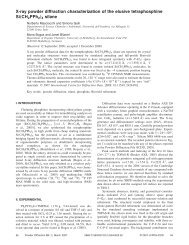
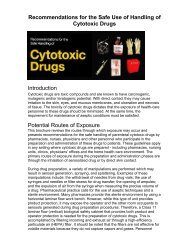
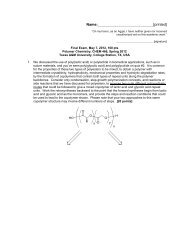

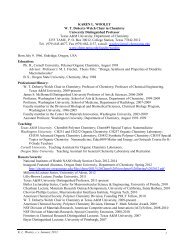
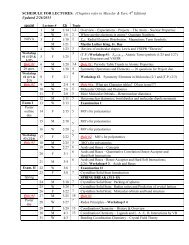
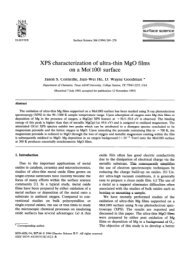
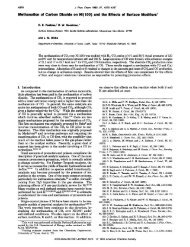
![Radical salts of TTF derivatives with the metal–metal bonded [Re2Cl8]](https://img.yumpu.com/10115211/1/190x253/radical-salts-of-ttf-derivatives-with-the-metal-metal-bonded-re2cl8.jpg?quality=85)



